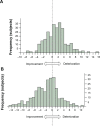Differential changes in quality of life components over 5 years in chronic obstructive pulmonary disease patients
- PMID: 25914531
- PMCID: PMC4401330
- DOI: 10.2147/COPD.S77586
Differential changes in quality of life components over 5 years in chronic obstructive pulmonary disease patients
Abstract
Background: The aim of the study was to examine the longitudinal change in quality of life components of patients with chronic obstructive pulmonary disease (COPD).
Methods: In the Hokkaido COPD Cohort Study, 261 subjects were appropriately treated and followed over 5 years with a 74% follow-up rate at the end. The longitudinal changes in St George's Respiratory Questionnaire (SGRQ) scores were annually evaluated with forced expiratory volume in 1 second (FEV1). The subjects were classified into the rapid decliners, slow decliners, and sustainers based on ΔFEV1/year.
Results: The activity component of SGRQ generally deteriorated over time, and its annual decline was the greatest in the rapid decliners (<25th percentile). In contrast, the symptom component improved significantly year by year in the sustainers (>75 percentile), and it did not deteriorate even in the rapid decliners. Of the baseline data, predictors for worsening of the activity component were older age and lower body mass index. Larger reversibility was related to symptom component improvement. Of the follow-up data, ΔFEV1/year was the best predictor for worsening of the components of SGRQ. Continuous smoking was another factor for worsening of the activity component. For the symptom component, a history of exacerbation by admission definition was the determinant of its deterioration, whereas use of beta agonists was related to improvement.
Conclusion: The longitudinal changes of quality of life and their determinants are markedly different and independent between its components. The activity component of SGRQ generally deteriorated over years, while the symptom component rather improved in some patients with COPD under appropriate treatment.
Keywords: SGRQ; annual change; exacerbation; forced expiratory volume in 1 second; smoking.
Figures



Similar articles
-
Health status in the TORCH study of COPD: treatment efficacy and other determinants of change.Respir Res. 2011 May 31;12(1):71. doi: 10.1186/1465-9921-12-71. Respir Res. 2011. PMID: 21627828 Free PMC article. Clinical Trial.
-
Deterioration of quality of life is associated with the exacerbation frequency in individuals with alpha-1-antitrypsin deficiency - analysis from the German Registry.Int J Chron Obstruct Pulmon Dis. 2017 May 12;12:1427-1437. doi: 10.2147/COPD.S130925. eCollection 2017. Int J Chron Obstruct Pulmon Dis. 2017. PMID: 28553095 Free PMC article.
-
Factors associated with inadequate diagnosis of COPD: On-Sint cohort analysis.Int J Chron Obstruct Pulmon Dis. 2015 May 18;10:961-7. doi: 10.2147/COPD.S79547. eCollection 2015. Int J Chron Obstruct Pulmon Dis. 2015. PMID: 26028969 Free PMC article.
-
The value of forced expiratory volume in 1 second decline in the assessment of chronic obstructive pulmonary disease progression.Am J Med. 2006 Oct;119(10 Suppl 1):4-11. doi: 10.1016/j.amjmed.2006.08.002. Am J Med. 2006. PMID: 16996894 Review.
-
Impact of tiotropium on the course of moderate-to-very severe chronic obstructive pulmonary disease: the UPLIFT trial.Expert Rev Respir Med. 2010 Jun;4(3):279-89. doi: 10.1586/ers.10.23. Expert Rev Respir Med. 2010. PMID: 20524910 Review.
Cited by
-
One-year clinically important deterioration and long-term clinical course in Japanese patients with COPD: a multicenter observational cohort study.BMC Pulm Med. 2021 May 12;21(1):159. doi: 10.1186/s12890-021-01510-w. BMC Pulm Med. 2021. PMID: 33980194 Free PMC article.
-
Periodontal status and lung function decline in the community: the Hisayama study.Sci Rep. 2018 Sep 6;8(1):13354. doi: 10.1038/s41598-018-31610-3. Sci Rep. 2018. PMID: 30190577 Free PMC article. Clinical Trial.
-
Impact of Lung Function and Exacerbations on Health-Related Quality of Life in COPD Patients Within One Year: Real-World Analysis Based on Claims Data.Int J Chron Obstruct Pulmon Dis. 2021 Sep 21;16:2637-2651. doi: 10.2147/COPD.S313711. eCollection 2021. Int J Chron Obstruct Pulmon Dis. 2021. PMID: 34588773 Free PMC article.
-
Understanding low COPD exacerbation rates in Japan: a review and comparison with other countries.Int J Chron Obstruct Pulmon Dis. 2018 Oct 26;13:3459-3471. doi: 10.2147/COPD.S165187. eCollection 2018. Int J Chron Obstruct Pulmon Dis. 2018. PMID: 30464435 Free PMC article. Review.
-
Long-term outcomes following first short-term clinically important deterioration in COPD.Respir Res. 2018 Nov 20;19(1):222. doi: 10.1186/s12931-018-0928-3. Respir Res. 2018. PMID: 30453972 Free PMC article. Clinical Trial.
References
-
- Jones PW, Quirk FH, Baveystock CM. The St George’s Respiratory Questionnaire. Respir Med. 1991;85(Suppl B):25–31. discussion 33–37. - PubMed
-
- Jones PW, Quirk FH, Baveystock CM, Littlejohns P. A self-complete measure of health status for chronic airflow limitation. The St George’s Respiratory Questionnaire. Am Rev Respir Dis. 1992;145(6):1321–1327. - PubMed
-
- Vestbo J, Edwards LD, Scanlon PD, et al. ECLIPSE Investigators Changes in forced expiratory volume in 1 second over time in COPD. N Engl J Med. 2011;365(13):1184–1192. - PubMed
Publication types
MeSH terms
Substances
LinkOut - more resources
Full Text Sources
Medical

